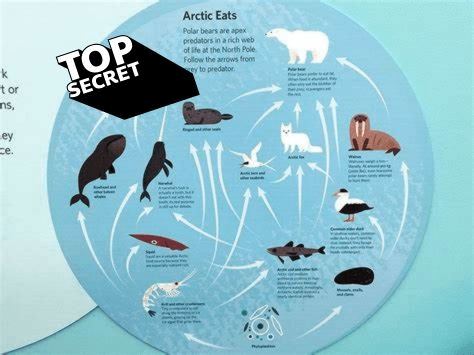This frozen substance is tasteless (taste) and sits at below 0° Celsius, which is frigid to the touch (touch).
What is Ice?
If this environmentally significant issue were to occur in the Polar Ice biome, the ice would melt away, water temperatures would drop, animals camouflage would become useless, and animals who have developed thicker coats would die of heat exhaustion.
What is climate change? (climate change effect)
This animal keeps the fish population in check, and males give pebbles to the females as a marriage proposal (biotic factor).
What is a Penguin?
This animal is the keystone species of the Arctic, meaning it greatly effects the Polar Ice biome's biological composition. This animal is the predator of the seal (predator/prey; keystone species)
What are Polar Bears?
This type of symbiotic relationship is commonly seen between arctic bees and flowers, where the bee receives nectar (food) from the flower, and the bee pollinates the flower (symbiotic relationship).
What is mutualism?
While walking across this white blanket of snow (sight), a silence crosses your ears (hear), and there is not a smell around (smell). This can be observed.
What is Polar Ice?
If this species of mammal were to be introduced into this biome, the habitat would be destroyed to make room for shelters, expansion, and the animals living here would be hunted out to almost extinction.
What are humans? (human introduction)
This large feline has a twin with yellow fur and also competes with the polar bear population for food (biotic factor).
What is a Snow Leopard?
The beluga whale eats many different critters, this one in particular has a hard outer shell that has to be broken into before it can be eaten. As humans, we eat this too(predator/prey)!
What are Clams?
These large animals use their strong sense of smell to locate its prey, sometimes stolen from another beard killings and to locate females to mate with, which can sometimes end in deadly brawls between the males, which can help keep the population of these beasts under control (competition for food and mates).
What are Polar Bears?
The Polar Bear and the Arctic Fox both have this colored feature that helps them camouflage into their environment (2 animal adaptations).
What is white fur?
If this aquatic animal were to go extinct, Polar Bears would lose their primary source of food as the apex predator, causing them to starve and possibly face extinction (hypothetical extinction).
What is a Seal?
This sly species feces helps disperse valuable nutrients across their environment (biotic factor).
What is the Arctic Fox?
This flying predator of the Arctic hare has beady yellow eyes that help it locate its prey in the snowy biome (predator/prey).
What is the Snowy Owl?
These feisty animals will become very hostile when predators enter their environment, they even attack researchers by hitting them with their flippers when they come into the colony's territory, because there are sparse areas where these creatures can thrive (competition for territory).
What are Penguins?
This plant is one of the only ones that are able to photosynthesize while frozen at temperatures as low as 20° Celsius (plant adaptation).
What is lichen?

Without this black and while aquatic species, the Narwhale and the Seal would overpopulate, due to the Phytoplankton's efficient productivity in fueling the food chain (food web)
What is the Orca?
This freezing blanket covers the entire ground, containing dead organisms which if released, have the potential to become a viral biohazard (abiotic factor).
What is permafrost?
This relationship is a toxic one; one species benefits while the other one is harmed. This can be seen between tapeworms, who eat what their host animal eats, and wolves, who become under nourished from this parasite (symbolic relationships).
What is parasitism?
Beluga whales communicate under water by using loud squeaks, clicks and chirps. this is an example what what type of behavior(learned and innate behavior)?
What is a learned behavior?
This triangular leafed plant has unique adaptations that not only allow it to survive in all biomes, but it can also help restore damages ecosystems by providing a habitat and improving water quality (plant adaptation).
What are sedges?
If this type of species were to be introduced to the Polar ice biome, it would exist unchecked by the natural food web and the current organisms that live here would suffer from extinction, competition for food, competition for space, and would cause changes to the natural environment.
What are invasive species? (non-native/invasive species)
Despite few plants conducting photosynthesis, these resources are abundant in the environment providing light and something to breathe (2 abiotic factors).
What are sunlight and oxygen?
The symbiotic relationship between Arctic foxes and polar bears are mostly one sided. The polar bear kills its prey, and the Arctic fox comes after and finishes whatever the polar bear did not (symbiotic relationship).
What is commensalism?
Beluga whales often return to their own birth place to feed and give brith to their own calves. This is an example of what type of behavior (learned and innate behavior)?
What is a innate behavior?